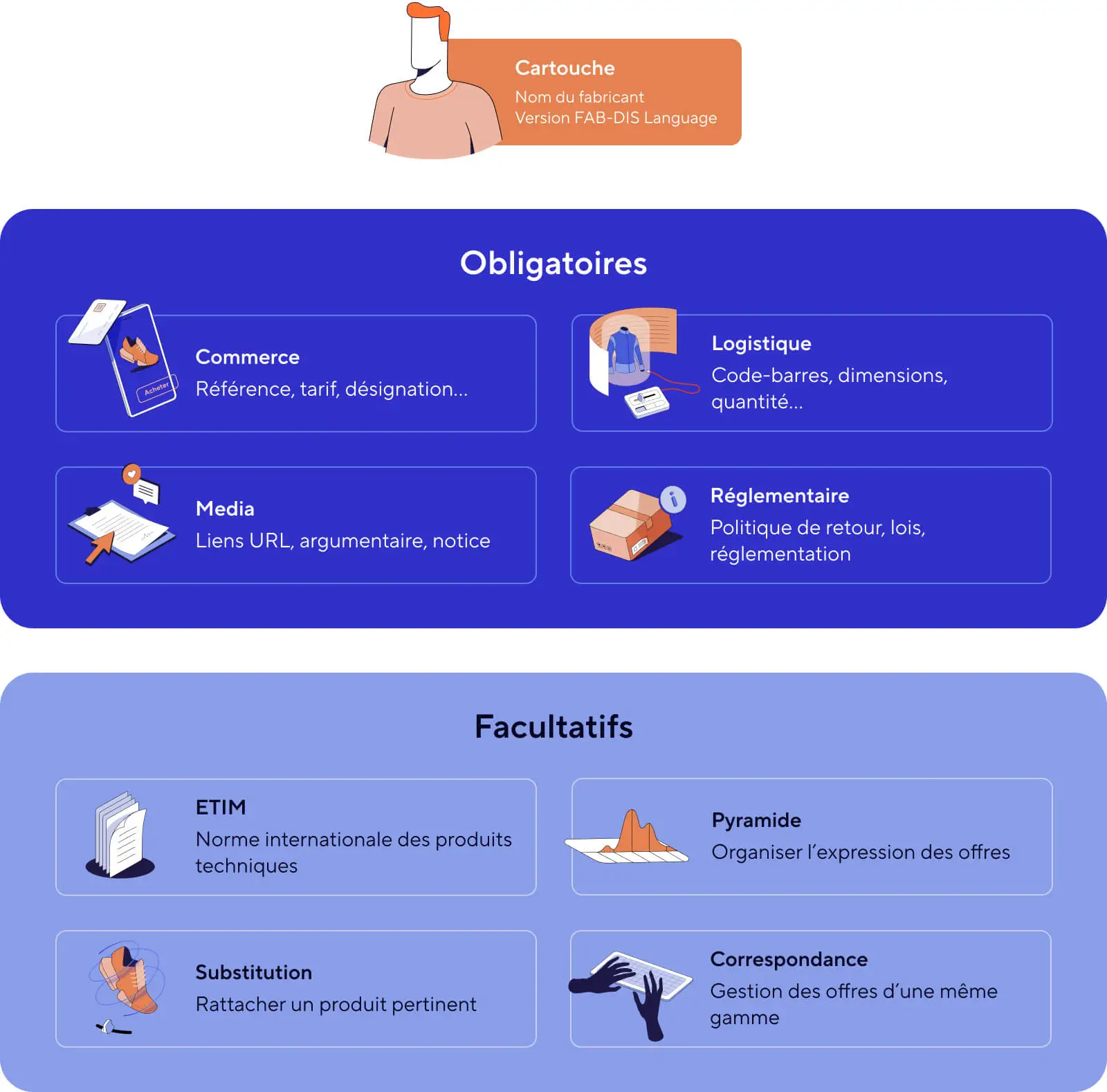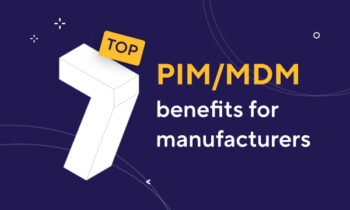All about FAB-DIS: interview with MaPS System
The FAB-DIS format has become essential for structuring product data exchanges in the industry. However, understanding and implementing it can be complex—whether generating compliant files or managing incoming ones.
To shed more light on the subject, we spoke with Frédéric Eckert, Product Manager at MaPS System, about FAB-DIS and its integration into PIM and MDM projects.

What is MaPS System?
DATASOLUTION
Hi Frédéric! Thanks for joining us today. To start off, can you introduce yourself and tell us more about MaPS System?
Frédéric Eckert
My background is mainly focused on e-commerce and digital marketing. I previously ran a pure player company for eight years, then held several e-commerce and digital marketing leadership roles in different organizations. Just over three years ago, I joined MaPS System as a Key Account Project Manager. Following a series of internal developments, I moved into the Product team about a year and a half ago to lead change management and oversee major software development and evolution projects.
As for MaPS System, we’re a software publisher that helps companies optimize the centralization of their strategic master data—product information, visual assets, organizational data, and more. Today, we offer an all-in-one platform that combines MDM (Master Data Management), le PIM (Product Information Management) et le DAM (Digital Asset Management). Our solution supports manufacturers, brands, distributors, and service companies in meeting the growing demands of partners and markets with flexibility and efficiency, covering areas like data quality, compliance, reliability, and speed of access.
What is the FAB-DIS format?
DATASOLUTION
As part of their PIM or MDM projects, many of our clients and prospects mention the FAB-DIS format. Can you explain what FAB-DIS is?
Frédéric Eckert
FAB-DIS stands for “FABricants” (manufacturers) and “DIStributeurs” (distributors). It’s a standardized data exchange format designed to simplify the transmission of product information between manufacturers and distributors—especially in the construction, industrial, and infrastructure sectors.
The format is delivered as a structured Excel (.xlsx) file, organized into multiple tabs known as “blocks.” These cover various aspects such as commercial, logistical, media, and regulatory data. By adopting FAB-DIS, companies can streamline and accelerate product listing processes, improve data quality, and reduce time to market.

What are the benefits of the FAB-DIS format?
DATASOLUTION
And what are the key benefits of FAB-DIS?
Frédéric Eckert
This standardization makes it much easier to exchange product data between manufacturers and distributors, ultimately improving the efficiency and reliability of commercial processes.
FAB-DIS offers several advantages:
- it standardizes product data management between manufacturers and distributors
- it improves data quality and reliability, helping to avoid errors
- it speeds up time-to-market by simplifying product onboarding into distributor catalogs
- it boosts productivity by streamlining data handling and integration
- and it ensures regulatory compliance for product information
Which sectors use the FAB-DIS format?
DATASOLUTION
Which industries make the most use of the FAB-DIS format?
Frédéric Eckert
The FAB-DIS format is widely adopted in the construction, industrial, and infrastructure sectors. It’s used by a range of businesses, including:
- Manufacturers, such as producers of electrical equipment, bathroom fixtures, heating systems, and DIY tools
- Distributors, including wholesalers and specialized retailers of building materials, electrical supplies, bathroom products, and more
More specifically, key sectors include:
- Electrical: electrical equipment, lighting systems
- Sanitary: bathroom fixtures and fittings
- Heating and air conditioning: HVAC systems
- Tools and DIY: hand and power tools, home improvement equipment
- Home decor: interior decoration materials and accessories
What are the differences between FAB-DIS and ETIM?
DATASOLUTION
There are other types of classifications—ETIM, for example. What are the key differences between FAB-DIS and ETIM?
Frédéric Eckert
FAB-DIS and classification models like ETIM share a common goal: structuring product data exchanges. However, they differ in their purpose, structure, and scope of application.
Purpose
- FAB-DIS is designed to facilitate product data exchange between business partners, mainly manufacturers and distributors.
- ETIM (Electro-Technical Information Model) is a technical classification system that standardizes how products are described based on characteristics, independently of any commercial relationship.
Structure and content
- FAB-DIS follows a standardized Excel-based format, organized into data blocks depending on their function: required blocks (commercial, logistics, media, regulatory) and conditional blocks (variants, cross-references, discontinued items, replacements…). Each product is described across multiple dimensions (commercial, technical, logistical, regulatory), making integration easier for distributors’ systems.
- ETIM is built around a hierarchical structure of product classes, groups, and standardized technical attributes. A product belongs to a single ETIM class (e.g., LED lamp = ETIM EC000109), with a set of predefined characteristics (e.g., wattage, color temperature) and associated values (e.g., 10W, 4000K). The goal is to ensure universal, consistent interpretation of technical specifications through a standardized model.
Scope of application
| CRITERIA | FAB-DIS | ETIM |
| FILE TYPE | Excel (XLSX) | Modèle structuré XML / JSON / Excel |
| ORIENTATION | Commercial and marketing | Technical structuring of products |
| Primary use | Distributor catalogs, product listing | Structuring of technical product data |
| Main sectors Industries concerned |
Construction electrical, industrial, DIY |
Industry electrical, plumbing, heating, ventilation |
| INTEGRATION WITH PIM / ERP | Yes, compatible with PIM, ERP, and eCommerce platforms | Yes, used in PIM and ERP systems for classification |
Are the FAB-DIS and ETIM formats complementary?
DATASOLUTION
Thanks for the clarification. Can FAB-DIS and ETIM be used together?
Frédéric Eckert
Yes, FAB-DIS and ETIM are complementary and can absolutely be used together:
- A FAB-DIS file can include ETIM classification to enhance the readability and standardization of technical data.
- A manufacturer can structure product information using ETIM, then export it in FAB-DIS format to share with distributors.
Example: A lighting manufacturer uses ETIM to classify its LED lamps (e.g., ETIM class EC000109). Then, it generates a FAB-DIS file to send to distributors, containing all relevant commercial, logistical, and technical information.
In fact, the MaPS System PIM allows for the integration of both models to manage product data efficiently.
What should you consider when using the FAB-DIS format?
DATASOLUTION
Back to FAB-DIS—are there any key points to keep in mind when implementing it?
Frédéric Eckert
Like any standard, FAB-DIS requires strict adherence to several aspects.
Data structure
- Follow the standardized structure: FAB-DIS files are organized into blocks, represented as tabs in an Excel (.xlsx) file (e.g., Commercial, Logistics, Regulatory, Media)
- Ensure each block is correctly filled: missing or improperly structured data can cause import errors
- Avoid duplicate entries or inconsistencies across blocks
Example: A product missing dimensions or weight in the Logistics block may cause issues with inventory management for the distributor.
Data quality and compliance
- Ensure information accuracy: poorly described products can be incorrectly listed or rejected by the market
- Meet regulatory standards: certifications, CE markings, and eco-contributions must be properly filled in
- Ensure alignment with ETIM: certain technical data must follow ETIM classifications
(Note: ETIM data is often used to filter products and extract qualitative information across platforms.)
Example: An overly long product description may exceed FAB-DIS character limits and get rejected by a distributor.
Regular updates
- Keep files up to date: product changes (pricing, stock, new SKUs) must be regularly integrated
- Monitor FAB-DIS format updates: version 3.0 introduced new requirements and optional blocks to enhance data exchange (additions, removals, redesigns)
- Anticipate product lifecycle events such as discontinuations and substitutions
Example: A discontinued product must be listed in the “C05 – Discontinued” block, with a replacement reference if available.
Automation and pre-export validation
- Avoid manual entry to reduce human error
- Use a FAB-DIS Inside certified solution (like MaPS System) to automate file creation and validation
- Test files before sending using tools like Easy-Check by FAB-DIS to catch and correct errors early
Example: A poorly structured file or one with incomplete data risks being rejected by the distributor, causing delays in product publication.
MaPS System and FAB-DIS
DATASOLUTION
More concretely, how does the MaPS System platform support the use of FAB-DIS?
Frédéric Eckert
MaPS System is a FAB-DIS Inside-certified solution, designed to simplify and automate the entire FAB-DIS file management process.
Thanks to its integrated PIM, MDM, and DAM capabilities, MaPS enables companies to:
- centralize and structure product data in a single source of truth
- automate the creation of FAB-DIS files, in compliance with the latest version of the standard
- ensure data quality and compliance before export
- streamline file exchange and updates with distributors and partners
On a practical level, MaPS System meets manufacturers’ needs through:
- its DataExport module, which generates 100% compliant FAB-DIS files in just a few clicks—without tedious manual work
- its DataImport module, which allows the import of files based on the FAB-DIS 3.0 standard
These operations are fully automatable.
DATASOLUTION
And how does the MaPS System platform ensure FAB-DIS compliance?
Frédéric Eckert
FAB-DIS compliance is crucial to avoid file rejections and speed up product integration with distributors. MaPS System ensures this compliance through several key features:
- Automated quality control: using exchanges with Easy-Check and a system of configurable filters, the platform detects errors and inconsistencies before export (e.g., missing data, incorrect formats).
- Validation with Easy-Check by FAB-DIS: MaPS System has a direct communication flow with this verification tool, allowing near-instant validation status and providing a compliance number for file delivery.
- FAB-DIS block compliance: files are structured according to the required blocks (commercial, logistics, media, regulatory, etc.).
- Automatic updates: the platform evolves with new FAB-DIS versions to ensure continuous standards compliance.
This way, MaPS System users can be confident that their files are validated and compliant before sending them to distributors—avoiding back-and-forth delays.
DATASOLUTION
What time savings can be achieved by generating FAB-DIS files with MaPS System?
Frédéric Eckert
MaPS System offers significant time savings in creating and managing FAB-DIS files, notably through:
- Automatic generation in a few clicks: no need to manually build Excel files—everything is automated
- Up to 80% fewer errors: fewer corrections and back-and-forths with distributors, thanks to Easy-Check-powered quality control
- Up to 40% reduction in time-to-market: validated files are quickly ready for use by distributors
- Mass updates: with PIM, updates (pricing, specs, descriptions) apply to multiple products at once—no manual edits required
- Simplified product base updates: easily import FAB-DIS files from suppliers directly into MaPS
In short, MaPS System allows manufacturers to generate, validate, and export FAB-DIS files in record time—so they can focus on their core business, not complex data entry.
DATASOLUTION
One last question: why use MaPS System to manage FAB-DIS and ETIM formats?
Frédéric Eckert
As a FAB-DIS Inside-certified platform, MaPS System meets all compliance requirements and allows you to centralize, structure, and export data in multiple formats:
- Support for the latest FAB-DIS 3.0 version
- Unified product information management, regardless of format (FAB-DIS, ETIM, eCommerce, ERP, etc.)
- Automated FAB-DIS export with full integration of ETIM technical classifications
- Import of FAB-DIS 3.0 files
- Reliable data validation via Easy-Check quality controls
It’s a future-ready platform that enables seamless data governance and exchange across the entire product information lifecycle.
Need more information?
To dive deeper into PIM/MDM and the FAB-DIS format,
feel free to reach out to the teams at MaPS System and DATASOLUTION.





MaPS System enables manufacturers to generate, validate, and export FAB-DIS files in record time, allowing them to focus on their core business instead of complex data entry tasks.
Frédéric Eckert, Product Manager, MaPS System